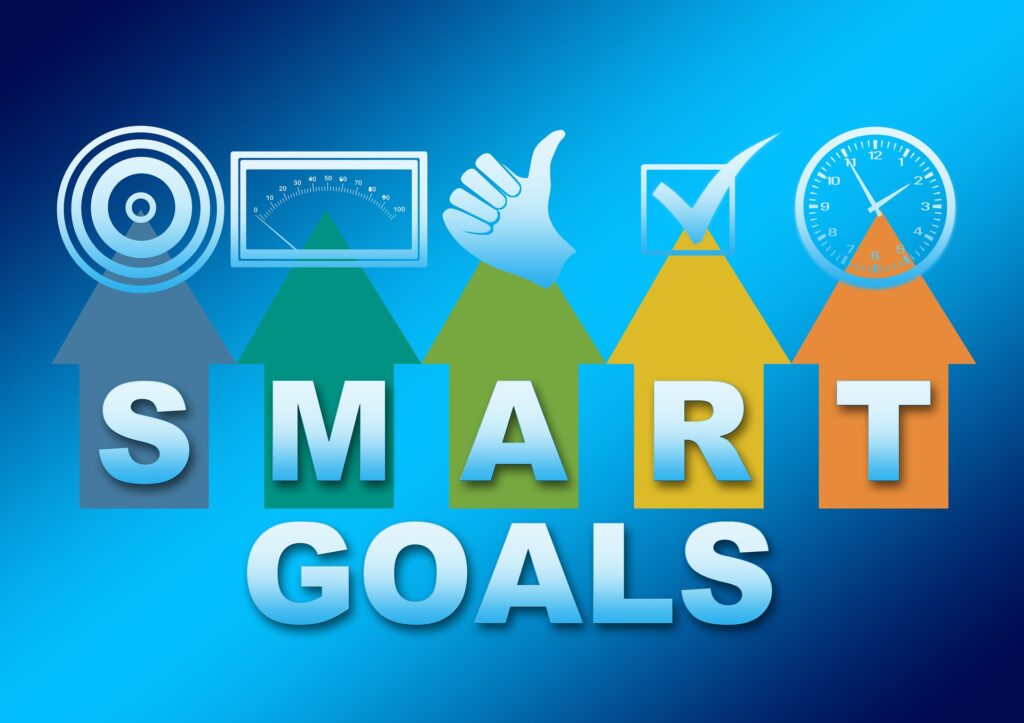
10 Powerful Steps to Achieve Your Goals in 2022
Have you tried to set goals each year only to see them flounder even before January is over?
Do you want to start on the right foot and stay there throughout 2022?
Before you set your goals for the year, you need to address the issues that caused you to fall short of them in prior years. Reflect on what you did or didn’t do, such as setting unrealistic goals or having no measurable means for them. You may want to earn $1M in 2022, but if you only made $50,000 the year before, that’s an impracticable goal. Goals that have no clear direction include being healthy and fit or having more fun in life; they lack specificity.
“A goal without a plan is only a dream.” ~ Brian Tracy
HOW TO ACHIEVE YOUR GOALS
- START SMALL. If you need $5,000 for a vacation, write down how much you’ll need to save. Then start by putting away $50 a week for four weeks. The following month increase it to $100, and add to it every month, even if it’s minimal. If you want to cut your sugar intake, go without sugar for one day a week, then two days the next week, and so on. The point is, you’re setting measurable goals and developing a habit of achieving them. You’ll then be mentally prepared to take on larger targets, such as buying a luxury BMW or a new oceanfront home. Set goals that inspire and motivate you.
- WRITE THEM DOWN. Scientific studies have proven that people who write down their goals have a much better chance of attaining them. Writing down goals happens on two levels: encoding and external storage.

- VISUALIZE WHAT YOU WANT. You can use many visualization techniques, but two of my favorites are Visualizing Yourself Succeeding Your Goals and Creating a Vision Board. To use the power of visualization effectively, take a few minutes each morning and evening to clearly visualize what your life will look like, as well as how you will feel, achieving your goal. A vision board is typically a collection of photographs and images that narrow your focus and remind you of your dreams. Your vision board should focus on how you want to feel, not just on what you want. However, the more your board focuses on how you want to feel, the more it will come to life.
- IDENTIFY ANY BLOCKS YOU MAY HAVE. If you set the same goals every year and fail to reach them, you’re being held back by something. Once identified, you’ll need to take the time and discover what that something is and take the steps necessary to overcome that or any other roadblocks

- CREATE MILESTONES AND TRACK PROGRESS. Charting your progress gives you little “wins” to celebrate, encouraging you to continue. When you divide your goals into small achievable steps, they feel more attainable, and reaching each one creates the momentum you need to keep moving forward. And establishing a method for tracking your goals is essential for knowing whether you’re progressing or not.
- TAKE ACTION EVERY DAY. Use Jack Canfield’s Success Principle #23, Practice the Rule of 5. Here’s how it works: Every day, identify five specific things you will accomplish to get closer to your goal and don’t call it quits until you cross each one off your list. If you take five chops with an ax to a giant redwood each day, eventually, it will be

- HAVE A SUPPORT SYSTEM. Trying to accomplish a goal entirely by yourself can be lonely and overwhelming. Tell everyone who will listen to your plans and how you intend to bring them to fruition. The more people you tell, the better chance someone may assist you in surpassing your target. Also, having support leads to accountability, 8. which helps you make steady progress as you strive toward your goals.
- PREPARE AND ADJUST FOR SETBACKS. No matter how clear your path is or how inspired and motivated you are when you first set out on your journey, the chances are high that something will come along and throw a curveball your way that diverts your chosen path.

- CHALLENGE YOURSELF. If you are completing all the steps necessary to reach your goals and still haven’t made the headway you desire, think about taking action out of your comfort zone that can launch yourself closer to what you want. Practicing new behaviors will help you create a new life. Doing things that stretch you makes life exciting and makes the feeling of achievement that much sweeter. Don’t be afraid to embrace change and challenge yourself to do something BIG!
- REWARD YOURSELF. Working all the time to reach your goals can be draining and tiresome. A way to re-charge your power is to celebrate your achievements, no matter how small they may be. When you go the extra mile, reward yourself. Tick it off the list. Your self-confidence will flourish and give you the push to strive even higher and go for bigger goals. Celebrate the completion with something similar; take a walk in nature for 15 minutes if you lost 5 pounds, but don’t take the day off!

SETTING SMART GOALS
What are SMART Goals?
Smart goals are Specific—Measurable—Attainable—Relevant—and, Time-bounded. Smart goal setting brings structure to them; they become easy to verify due to their milestones. Implementing them helps ensure you stay focused on achieving realistic goals that will accelerate your progress to achieving your dreams.
S—SPECIFIC
When setting a goal, be specific about what you want to accomplish. It should answer questions, not raise more of them. WHO? Who needs to be involved? WHAT? What exactly are you trying to accomplish or achieve? WHEN? When will you achieve it? WHERE? If there’s a location, where is it? WHY? Why do you want the goal?
M—MEASURABLE
Effective goals are measurable; they should include specific target numbers. For example: How much, by when?
Set realistic goals that are possible but stretch your abilities and skills. You may have to learn something that expands on what you already know. When you set attainable goals, you may be able to identify previously overlooked opportunities or resources that can bring you closer to them. You may even have to chunk bigger goals into smaller, more realistic ones that you can achieve within a year or less.
A—ATTAINABLE
Your goal needs to be realistic and attainable to be successful. Determine the factors of what you can actually accomplish within your time and financial limits, and set goals that stretch your abilities. It may even require you to learn a new skill or change your attitude. The goal is meant to inspire motivation, not discouragement. Think about:
- How to accomplish the goal
- If you have the tools/skills necessary
- If not, consider what it would take to attain them
R—RELEVANT
Your goals must be relevant and align with your true purpose and other goals. When they are, you’ll be able to focus on what you need to do to get ahead while keeping your priorities consistent. Questions you can ask yourself are:
- Does this seem worthwhile?
- Is this the right time?
- Does this align with my true purpose/inner self?
- Is this the direction I want my life to go?
T—TIME-BOUND
Every goal needs a target date—a specific deadline for achieving it. Committing to a target completion date creates accountability and motivates you to keep moving forward. It means you’ll be able to recognize when 
- When is the target date?
- What can I do today to move toward it?
- What can I do one month from now?
- What can I do six months from now?
SMART goal setting is a powerful tool that gives you the clarity, focus, and motivation you need to attain your goals. It gives you the support for knowing how to set and achieve big goals for anything you want in life. What it does not do is take action for you.
You set goals all day long, but unless you take consistent action moving toward them, you’ll remain stuck where you are. Commit to taking 100% responsibility for every aspect of your life and goal-planning. Then choose what you want; decide what actions you will take to create it; take those actions step-by-step until you reach them.
If you find yourself stuck unable to move forward, you may have a limiting belief holding you back. If you’re unsure of what’s blocking you, schedule your free 15-minute assessment with me now to determine what it is.
I can help you become unstoppable!

“Life takes on meaning when you become motivated, set goals, and charge after them in an unstoppable manner.” ~ Les Brown

